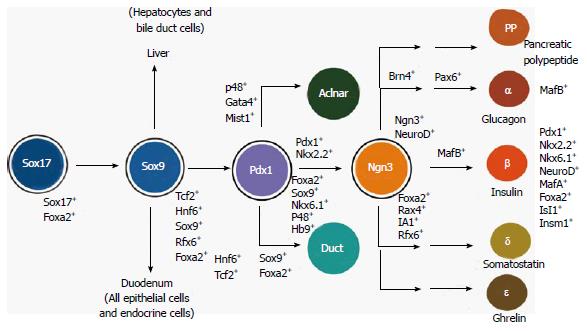Copyright
©The Author(s) 2015.
World J Stem Cells. Dec 26, 2015; 7(11): 1251-1261
Published online Dec 26, 2015. doi: 10.4252/wjsc.v7.i11.1251
Published online Dec 26, 2015. doi: 10.4252/wjsc.v7.i11.1251
Figure 1 Multiple fate selections allow the development of the pancreas islet lineages.
Committed from one of three germ layers (the ectoderm, mesoderm and endoderm) during gastrulation, the definitive endodermal cells (DE) are marked by the expression of Sox17 (the Sry-related HMG box transcription factor 17) and foxhead homeobox 2a (Foxa2). Along the anterior-posterior axis the DE is divided into foregut (giving rise to the lung, thyroid and esophagus), posterior foregut (PF), marked by the expression of the transcription factor hepatocyte nuclear factor 4a (Hnf4a) and hindgut (committing the intestine and colon). In vitro, retinoid acid would direct the DE cells to PF cells. Largely to the liver and duodenum, a fraction of the PF cells give rise to pancreatic progenitors (PP, marked by the expression of the transcription factor Pdx1). Mostly to the exocrine and ductal tissues, the PP commits to progenitors of the endocrine islet lineages [IP, marked by the expression of Neurog3, as well as neural differentiation 1 (NeuroD ), insulinoma associated 1 (IA1), Islet 1 (Isl1), paired box factor 6 (Pax6) and Rfx6]. The IP then differentiates into at least five types of islet cells [α, β, δ (somatostatin), pancreatic polypeptide (PP) and ε (ghrelin)].
- Citation: Jiang FX, Morahan G. Multipotent pancreas progenitors: Inconclusive but pivotal topic. World J Stem Cells 2015; 7(11): 1251-1261
- URL: https://www.wjgnet.com/1948-0210/full/v7/i11/1251.htm
- DOI: https://dx.doi.org/10.4252/wjsc.v7.i11.1251









